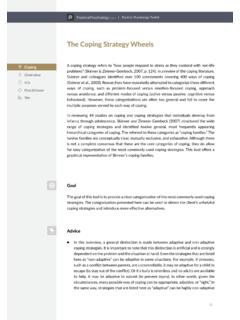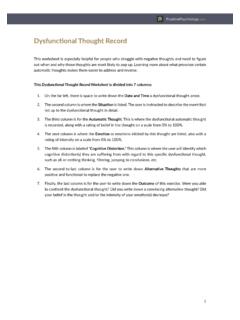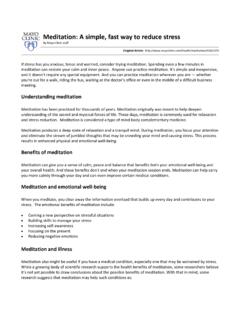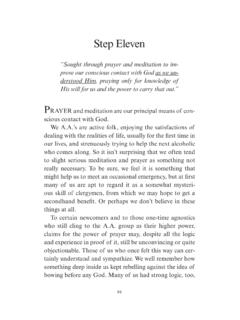Transcription of Table of Contents - PositivePsychology.com
1 Table of Contents chapter one: mindfulness exercises for adults 2. 4 Mindfulness Activities for Group Therapy 3. 6 Mindfulness Interventions for Adults 9. Introducing Dialectical Behavioral Therapy (DBT) 15. 5 Mindfulness Exercises from Dialectical Behavioural Therapy 17. Mindfulness Techniques for Depression, Anger, Addiction, and Anxiety 19. chapter two: mindfulness activities for children 28. 4 Mindfulness Activities for Children 30. 15 Tips for Teaching Mindfulness to Kids 32. 8 Mindfulness Games, YouTube Videos, and Apps to Support Your Teachings 33. 3 Mindfulness Training Classes For Children with Anxiety 36. The Basics: Teaching Essential Mindfulness Practices 37. Mindfulness meditation for Very Young Children 38. The Benefits Of Mindfulness In Schools 39. references 41. chapter one I. Mindfulness Exercises For Adults Mindfulness Exercises For Adults People who meditate are happier, healthier, and more successful than those who don't.
2 Those amazing benefits of practicing meditation and mindfulness make you want to try it yourself. Good chance you have already tried meditation or mindfulness before. Maybe you decided after a few frustrating attempts that you must be one of those people with an errant mind that just won't follow instructions. This is a limiting belief. Like any skill, mindfulness takes practice. Try it again! Now don't roll your eyes. Sometimes the only thing standing between our goals and us is a little bit of direction. Hopefully, this chapter can provide the direction you need to give mindfulness a try in your own life or in your therapy or coaching sessions. Let's dive in! 4 mindfulness activities for group therapy In many cases, group therapy that incorporates mindfulness has shown some promising results. It has proven to be as effective as cognitive behavioral therapy (CBT), a staple of the clinical psychology world (Kocovski, Fleming, Hawley, Huta, & Antony, 2013).
3 There is also evidence to show that group mindfulness therapy is also as effective as individual CBT (Sundquist et al., 2015). In a global climate with relatively few clinical psychologists in relation to the demand, and in which individual therapy time is limited and expensive, the proven efficacy of group-based therapy is really good news. MINDFULNESS EXERCISES LI B RAR Y | 3. Even if you're not currently attending therapy or feel no need to visit a therapist, or are a therapist looking to expand your skills, there are mindfulness-focused groups that attempt to share and deepen meditation practice without an added therapeutic focus of stress, anxiety, or other mental health problems (Brach, 2016). FLEMING & KOCOVSKI'S TREATMENT PLAN. One such group mindfulness-based treatment program by Fleming & Kocovski (2007) aimed to reduce social anxiety.
4 It is a good example of how mindfulness exercises can be incorporated into a group setting for its various benefits. In this example, the exercises used have proven effective for treating social anxiety disorder in particular; however, they can be applied to many other group settings with positive results. The treatment plan involves groups of about 8 members meeting for 2 hours, every week for 12 weeks. The first portion of each session is devoted to a short mindfulness exercise and discussion.`. The treatment plan's mindfulness exercises went as follows: bodyscan Session 1: Raisin Exercise The Body Scan, as the name suggests, entails Session 2: Body Scan bringing awareness to each part of the body. Session 3: Mindful Seeing Session 4: Mindfulness of the breath, sounds and thoughts Session 5: Acceptance of thoughts and feelings exercise Session 6: Acceptance of Social Anxiety Session 7: Mountain meditation Session 8: Acceptance of Social Anxiety Session 9: Breath Focus without Guidance Session 10: Lake meditation Session 11: Non guided Breath Focus There are many different mindfulness exercises mentioned here which were specifically put together for the aim of reducing social anxiety disorder; however, the first three exercises are commonly used in group sessions to encourage mindfulness.
5 A description of each of these three group exercises can be found below: MINDFULNESS EXERCISES LIBRARY | 4. 1. THE RAISIN EXERCISE. This is a great introductory exercise for beginners to start practicing mindfulness, since it can be attempted by anyone with any kind of food (although one with an interesting or unusual texture, smell, or taste is best). In this exercise, the facilitator provides participants with a few raisins and asks that they pretend they have never seen a raisin before. The facilitator then asks that the group pay careful attention to: The way the raisin looks How it feels How their skin responds to its manipulation Its smell Its taste Focusing on the single object of the raisin is meant to bring the participant's mind to the present, to what is right in front of them. By focusing on the raisin in their hand and making a point to notice everything about it, they are unlikely to be expending energy, time and attention on worrying or ruminating about other parts of their lives It is nearly impossible to avoid practicing mindfulness when you follow these instructions and take notice of what is in front of you in the present moment.
6 2. THE BODY SCAN. Another popular exercise for practitioners of mindfulness is called the Body Scan. It requires very little in the way of props or tools, and it is also easily accessible for most beginners. Would you like to follow a Body Scan right now? Try this 30 minute guided narrative by expert and founder of Mindfulness Based Stress Reduction Jon Kabat Zinn: step 1: the Body Scan begins with the participants lying on their backs MINDFULNESS EXERCISES LI B RAR Y | 5. with their palms facing up and their feet falling slightly exercise can also be done sitting on a chair with feet resting on the floor. step 2: the facilitator then asks the participants to lie very still for the duration of the exercise, and move with awareness if it becomes necessary to adjust their position. step 3: next, the facilitator begins guiding the Body Scan.
7 Participants begin by bringing awareness to the breath, noticing the rhythm, the experience of breathing in and expelling out. The facilitator explains that nobody should try to change the way they are breathing but rather just hold gentle awareness on the breath. step 4: next, the facilitator guides attention to the body: how it feels, the texture of clothing against the skin, the contours of the surface on which the body is resting, the temperature of the body and the environment. step 5: the facilitator guides awareness to the parts of the body that are tingling, sore, or feeling particularly heavy or light, s/he asks the participants to note any areas of their body where they don't feel any sensations at all or are hypersensitive. A typical Body Scan runs through each part of the body, paying special attention to the way each area feels, the scan usually moves as follows: From toes of both feet to the rest of the feet (top, bottom, ankle) then to the Lower legs Knees Thighs and Pelvic region- buttocks, tailbone, pelvic bone, genitals.
8 From there moving to MINDFULNESS EXERCISES LIBRARY | 6. The Abdomen, then the Chest Lower back Upper back- back ribs & shoulder blades Hands (fingers, palms, backs, wrists). Arms (lower, elbows, upper). Necklace Head (jaw, mouth, mouth, nose, cheeks, ears, eyes, foreheead, top). and finally ending with the blow hole (Fleming & Kocovski, 2007). After the Body Scan is complete and the participants feel ready to come back to the room they can slowly open their eyes and move naturally to a comfortable sitting position. Now that you have a firmer understanding of the Body Scan, check out this free PDF mindful body scan script which will help you facilitate this exercise for others within a group setting. 3. MINDFUL SEEING. For some, the absence of visual stimuli can feel stifling. After all, a healthy imagination does not come naturally to everyone.
9 The activity of Mindful Seeing may be helpful to anyone who identifies with this feeling. This is a simple exercise, requiring only a window with some kind of a view. The facilitator guides the group following these steps: step 1: find a space at a window where there are sights to be seen outside. step 2: look at everything there is to see. Avoid labeling and categorizing what you see outside the window; instead of thinking bird or stop sign , try to notice the colors, the patterns, or the textures. step 3: pay attention to the movement of the grass or leaves in the breeze, notice the many different shapes present in this small segment of the world you can see. Try to see the world outside the window from the perspective of someone unfamiliar with these sights. step 4: be observant, but not critical. Be aware, but not fixated.
10 MINDFULNESS EXERCISES LI B RAR Y | 7. step 5: if you become distracted, gently pull your mind away from those thoughts and notice a color or shape again to put you back in the right frame of mind. This exercise only lasts a few minutes, but can open up a world of discovery in an otherwise familiar place This extensive group treatment plan of Fleming and Kocovski's 2007 work offers a glimpse of how to use mindfulness in any kind of group session and provides detailed worksheets, exercises, and handouts which can provide inspiration and guidance for your group facilitation. 4. MINDFUL LISTENING. This last activity is extracted from the Positive Psychology Toolkit and introduces mindful listening as a group exercise. Mindful listening is an important skill and can be a great group mindfulness exercise. In general, people thrive when they feel fully heard and seen.









![[2] - PositivePsychology.com](/cache/preview/b/1/a/9/3/c/c/b/thumb-b1a93ccbb2fc47a8b1ab31172d1d18ec.jpg)


